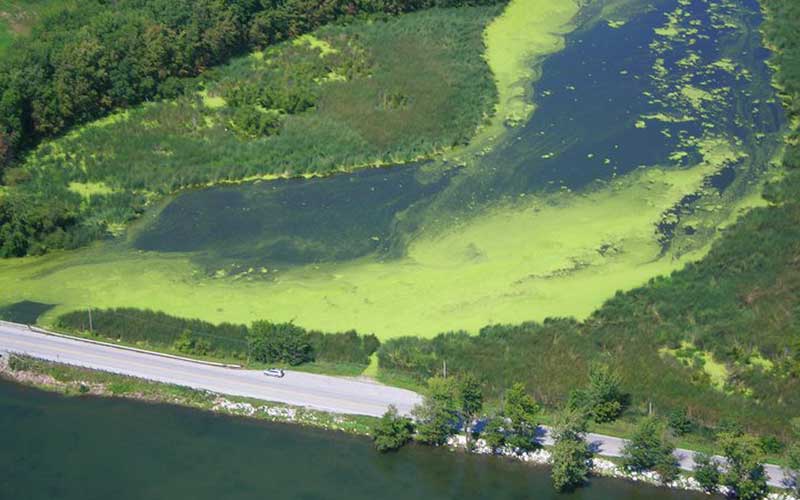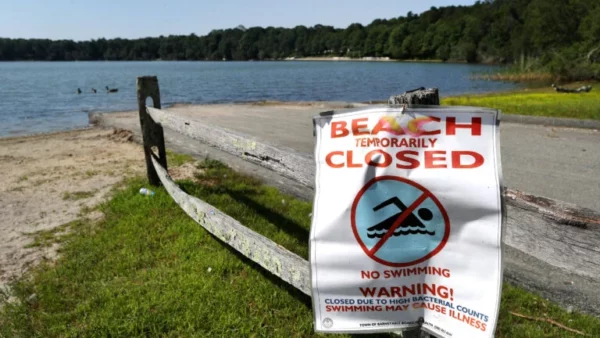
Unchecked agricultural pollution can lead to toxic blue-green algae outbreaks, which harm people and wildlife. Farmers are taking steps to curb their pollution, but feuding state agencies are making their work harder. Photo: Lighthawk
Over the last several years, Vermont’s farmers have made tremendous progress in cutting dangerous phosphorus pollution from their properties. Their efforts are critical to clean water in Vermont because that pollution causes toxic algae outbreaks that harm our waterways and threaten our health. But a longstanding turf war between two state agencies puts that progress at risk.
Currently, the state Agency of Natural Resources and the Agency of Agriculture, Food, and Markets both monitor farm pollution. However, the agencies refuse to cooperate – and often hamper each others’ efforts to enforce clean water laws. This bad blood creates a confusing enforcement system for farmers who want to do the right thing.
To solve this problem, the Agency of Agriculture, Food, and Markets must get out of the enforcement business. Since these agencies have failed to resolve their dispute themselves, CLF and our partners are asking the EPA to step in and do it for them.
Splitting Authority Between Two Agencies Creates Conflict and Confusion
Under Vermont law, the Agency of Natural Resources oversees agricultural pollution from so-called “point sources” on a farm, like a pipe or a ditch. The Agency of Agriculture, Food, and Markets regulates pollution from so-called “non-point sources,” like manure-laden water running off a farm field into a stream. But this jurisdictional split is based on a legal fiction, not on farming realities. That’s because it’s challenging to identify where exactly pollution originates on a farm.
Many people have criticized this divided jurisdiction, and for good reason. Even Julie Moore, Secretary of the Agency of Natural Resources, acknowledges it’s a problem. In an interagency memo, she concluded this split “has led to tension and conflict between the agencies, regulatory uncertainty for farmers, and more time-consuming outcomes for water quality resulting in more pollution.”
Reporting Delays Leave Water Pollution Unaddressed, Threatening Clean Water Progress
No other state has adopted this split authority model for clean water enforcement, and no wonder. It’s a recipe for failure. It has led to blatant interagency conflict – not to mention countless cases of serious agricultural pollution problems going unaddressed.
State law requires the Agency of Agriculture to immediately notify the Agency of Natural Resources of any evidence of point source discharge of agricultural waste. But the Agency of Agriculture routinely delays referring evidence of these pollution incidences – for months. As a result, the pollution – and the harm it causes – often continues unabated. Meanwhile, changing conditions on a farm could alter or eliminate important evidence.
The Agency of Agriculture must also document its farm investigations within 30 days. Instead, in 2019, Agriculture staff averaged 177 days to finalize farm inspection reports. For 14 of those inspections, the Agency of Agriculture waited more than a year.
These reports are meant to clarify where the pollution is occurring and provide other descriptive information for the Agency of Natural Resources. Withholding these reports leaves Natural Resources staff guessing. The Agency cannot properly enforce the Clean Water Act through guesswork – nor can it ensure progress toward cleaning up the pollution harming our waters.
The State Has Failed to Fix This Dysfunction, So We’re Asking the EPA to Step In
Over the past year, my team and I at CLF Vermont have reviewed thousands of public records from both agencies to investigate the impact of this turf war. We wanted to know how it affects our water quality, government efficiency, and the farming community. We reviewed farm inspection reports and enforcement documents, as well as three years of email correspondence between the two agencies.
The divided jurisdiction would be confusing enough if the two agencies cooperated. But our findings are clear: Their relationship is so broken that the Agency of Natural Resources cannot properly uphold its legal responsibilities to enforce the federal Clean Water Act.
Over decades and multiple administrations, both agencies have gone to significant lengths to overcome their broken relationship – to no avail. State leaders have failed to correct this dysfunctional system on their own. That’s why – in partnership with the Vermont Natural Resources Council and Lake Champlain Committee – CLF has called on the EPA to step in. We have asked the EPA to consider requiring Vermont to transfer all agricultural water quality regulation to the Agency of Natural Resources as a potential corrective action.
Such action will create clear rules for our farmers to follow and let the Department of Agriculture do what it does best: supporting Vermont’s farmers.
Our Farmers Are Part of the Solution to Clean Up Vermont’s Water
We can have clean water and healthy, productive farms across Vermont, but not under this broken regulatory system. The longstanding turf war between these two state agencies threatens recent progress farms have made in reducing pollution. We know Vermont’s farmers want to comply with our clean water laws. They face enough challenges – feuding agencies shouldn’t be one of them. The Agency of Natural Resources is well-equipped to carry out the Clean Water Act while being mindful of the impact on the farming community. It’s time they have that sole responsibility.



